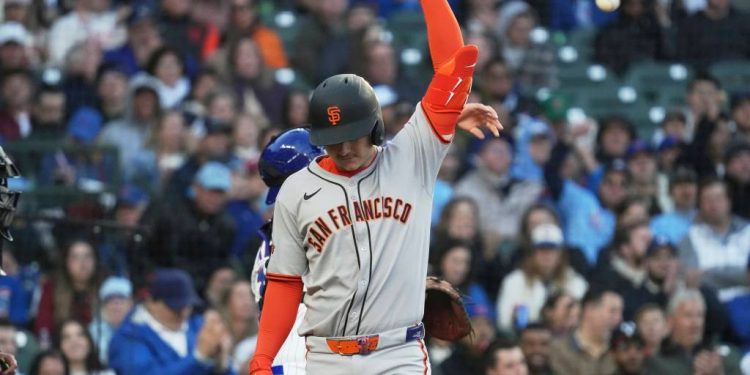Minneapolis – Patrick Bailey remains one of the best defensive baseball sensors. He is at the top of the rankings in the most defensive measures, and he is on the way to win a second consecutive Gold Gold prize.
Until now, its offense has been lower than the part.
More than 33 games, the Bailey striking Switch has an oblique bar line of. 194 / .234 / .276 without circuits. He entered Minneapolis with a sequence of four games, but is currently 52% worse than an average league striker, by OPS +. While Bailey’s main responsibility is to direct the pitch staff, the giants hope that the 25 -year -old will return to a bidirectional force.
“I know he is impatient to start,” said shot coach Pat Burrell. “I think it is in a fairly good place right now, so we will continue to monitor. He definitely gets his job. It’s quite difficult to manage one side, but with Switch strikers, it’s always a little more difficult. … I don’t think there is more.”
Bailey’s offensive difficulties are not a recent development. Since the second half of last season, Bailey has a .461 OPS on 291 plates appearances – the lowest brand among all players with at least 250 plates appearances. The lack of offense is particularly strange because Bailey had long periods of overwhelmingly higher than average.
In the first half of last season, Bailey posted an average of the stick of .283, 0.784 OPS, seven circuits and 31 products. Through war, as calculated by the Fangraphs, he was the most precious receiver of baseball at the break despite the missing time with a concussion. In the second half, on the other hand, Bailey had a .434 ops with a home run – a crisis which he attributed to his swing, not to packaging.
“We win ball games and I do what I can try to help the team win,” said Bailey. “Trying to stay consistent behind the marble and continue to manage the pitch staff, then put the work before the offensive matches to try to go where I want.”
Some elements stand out concerning Bailey’s offensive profile. On the one hand, it continues much more often.
In 2000, Bailey had a prosecution rate of 25.1% (72nd centile). In 2000, Bailey’s prosecution rate was 29.4% (37th centile). Its puff rate also increased from 23.4% last season to 36.1% this season. It is therefore not surprising that Bailey walks less and withdraws more.
“The most difficult thing to do is try to relax when you do not play – this is the name of this game. Everyone passes it. Nobody immunized it. We have seen it with a number of guys,” said Burrell. “To the point of continuing Patty, he is a guy who can work. He has a very good idea of what he is up there. He understands how they launch it. I think more than anything, it’s just that he gets comfortable.”
The manager added Bob Melvin: “He tends to walk and walk more deeply. He may be swinging a little too early at the moment.”
Bailey’s ball profile is also very different this season compared to last season. Here is the distribution from year to year of Bailey Balls on the ground, flying balls and line discs:
Field balls: 41.1% → 28.8%
Line pipes: 30.7% → 16.7%
Flight balls: 24.9% → 50.0%
“Balle on the ground generally do not play, but flying balls can also hurt,” said Bailey. “I’m just trying to hit more line records.”
Oppying launchers also avoid soft bailey spots. As a left -handed striker, Bailey feasts on high terrain in the striking area, especially inside and assid. As a right -handed striker, Bailey does his damage on the interior terrains. This season, launchers are away from where Bailey has succeeded.
“He’s not the only guy (in difficulty),” said Melvin. “So, sometimes, you put yourself a little pressure when you are not going hot. The last two years, it has started at great departures and it was the second half that he fell offensively. It’s just a matter of time for him.”
This time could soon approach.
During his current four game sequence, Bailey is 6 for 14 with two doubles, three products produced and three points scored. He collected two points produced in two plates matches during the 11th round of the Giants on Tuesday, leading to the shift race with a single, then bringing the ninth and last race with a sacrificial fly. It is an incredibly small – so small sample size that its collapse cannot be considered burst – but no steps in the right direction is too minute.
San Francisco’s colder bats have started to find life in recent days. Willy Adames has an oblique bar line of .306 / .432 / .639 with three circuits in his last 10 games. Lamonte Wade Jr. had a .461 OPS during its first 23 games but a .658 OPS in its last 10 games – still below the average but considerably better quality.
Bailey had stretching where he was one of the best strikers in San Francisco programming while playing the most trying position in baseball. The next few days will determine if he can return to this form.
“There will be a time when he will transport us as there were last year,” said Burrell.
California Daily Newspapers


